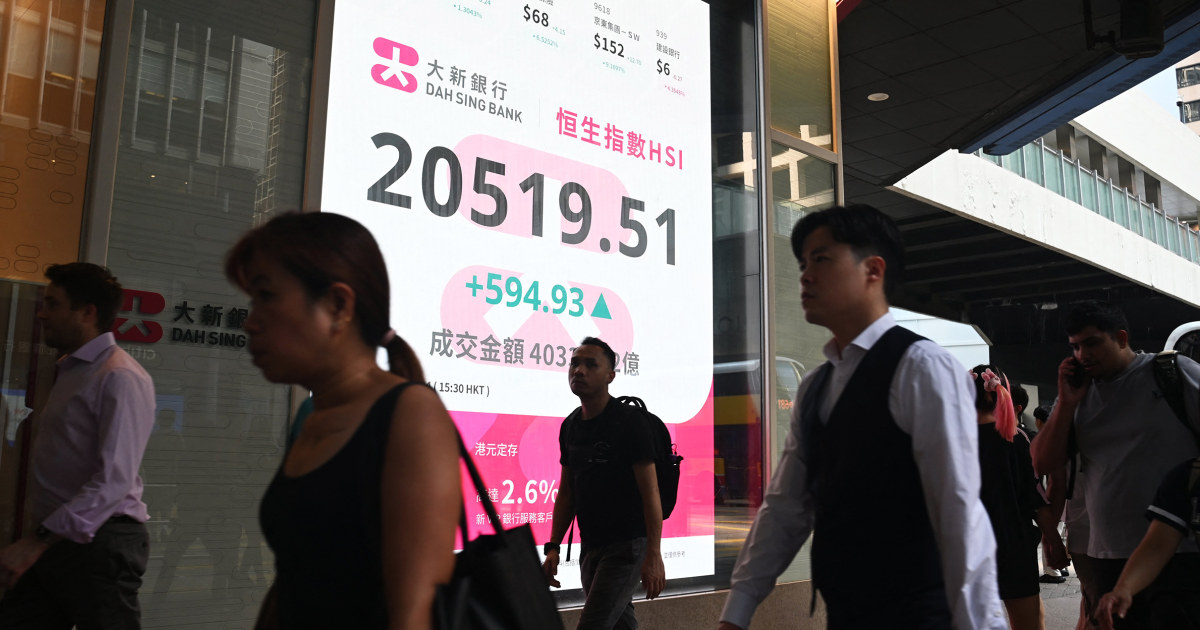Chinese markets clocked their best week in almost 16 years as the mainland’s CSI 300 rallied 15.7% this week, buoyed by several economic stimulus measures by the central bank.
The last time the index saw a bigger weekly gain was the week ending Nov. 14, 2008.
Hong Kong’s Hang Seng index recorded a weekly gain of 12.75%, making it the index’s best week since February 1998, according to FactSet data.
On Friday, the CSI 300 climbed 4.47% to close at 3,703.68, its highest level in about a year, while the HSI rose 3.32% and closed at 20,586.94, its highest since February 2023.
The rally comes as the People’s Bank of China cut its 7-day reverse repurchase rate to 1.5% from 1.7%, as well as slashed the reserve requirement ratio of financial institutions by 0.5 percentage point.
The PBOC said the RRR cut was intended to help “create a good monetary and financial environment for China’s stable economic growth and high-quality development,” according to a statement translated by Google.
China also released its industrial profit data for August, which saw a 17.8% plunge year on year. The drop follows a 4.1% year-on-year increase in July, the fastest pace in five months.
On a year-to-date basis, profits at large industrial firms grew at 0.5% to 4.65 trillion yuan ($663.47 billion) for the first eight months, compared with 3.6% in the first seven months.
As this data is up to August, investors will have to wait for the next batch of data to assess the effects of Tuesday’s stimulus measures.
Separately, at about 11 a.m. Shanghai time (11 p.m. Thursday ET), the Shanghai Stock Exchange reported that it was having “abnormal [and] slow transaction” in stock auctions since the market opened at 9:30 a.m.
The exchange said in a release that it was investigating the issues, according to a Google translation.
Other Asia-Pacific markets also mostly rose Friday, with investors also assessing September inflation numbers from Japan’s capital city of Tokyo, which is widely considered a leading indicator of nationwide trends.
Tokyo’s headline inflation rate eased to 2.2%, down from August’s 2.6%.
The core inflation rate — which strips out prices of fresh food — in the capital city came in at 2%, in line with expectations from economists polled by Reuters and down from 2.4% in August.
Japan’s Nikkei 225 rose 2.32%, closing at 39,829. The index hit its highest since July 19 and has erased all its losses after the July 30 Bank of Japan rate decision.
The broad-based Topix rose 0.73% to 2,740.94 after the CPI reading was announced. The Japanese yen weakened more than 1% against the U.S. dollar, before reversing course to strengthen 0.9% to trade at 143.4.
The yen strengthened after former defense minister Shigeru Ishiba won the race to lead Japan’s ruling party on Friday, lining him up to become the country’s next prime minister.
The leading candidate from the first round of voting was economic security minister Sanae Takaichi, who has advocated for a dovish monetary policy.
South Korea’s Kospi fell 0.82%, closing at 2,649.78 while the small-cap Kosdaq closed 0.6% lower at 774.49.
Australia’s S&P/ASX 200 climbed 0.10% and ended at 8,212.2, about 30 points away from its all-time high of 8,246.2.
Overnight in the U.S., all three major indexes rose, with the S&P 500 hitting a new record following the release of upbeat U.S. economic data.
The broad market index climbed 0.40% to 5,745.37, lifted by gains in Micron Technology. The Nasdaq Composite added 0.60%, and the Dow Jones Industrial Average advanced 0.62%.
A slate of fresh U.S. economic data also supported the market’s gains, with weekly jobless claims falling more than expected, pointing to a steady labor market.
Separately, the final reading of the U.S.’ second-quarter GDP was unrevised at 3%.


